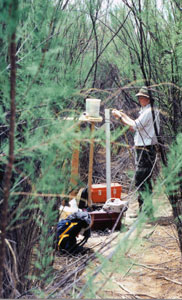






 |
 |

Talladega Wetland Field Site
Caption:
Dr. Albrey Arrington (standing) and Dr. Julie Olson, faculty from the Department of Biological Sciences at the University of Alabama, are shown at the Sipsey River floodplain in west-central Alabama.
The Sipsey River floodplain site is one of several field sites used for research by Ph.D. students enrolled in the Freshwater Sciences Interdisciplinary Doctoral program. The program is a collaborative effort between the University of Alabama and the University of New Mexico, and is funded by NSF's Integrative Graduate Education and Research Training (IGERT) program. [See related images: Water Lily Species Nymphaea odorata and Bosque del Apache Field Site.]
More about this Image
NSF's Integrative Graduate Education and Research Training program supports activities like the Freshwater Sciences Interdisciplinary Doctoral Program. The overall purpose of the freshwater sciences program was to provide Ph.D. students with the opportunity to prepare for careers that would effectively address the issue of how to maintain high-quality fresh water in the 21st century. The program emphasized interdisciplinary areas of aquatic ecology, environmental geology, and hydrology.
Both of the universities that participated in the program had a designated field site where students were able to take samples and perform field research. The sites were located at similar latitudes but with contrasting humid/wet and semi-arid climates. Students were able to broaden their perspectives by designing components of their dissertation research that were cross-regional and that allowed them to explore similarities and differences in approaches and questions in geographic regions with distinctly different climates.
The students investigated ecological, hydrological, and geochemical attributes of streams, rivers, and ground waters of the Mobile River and Middle Rio Grande basins. They formed links with organizations like the South Florida Water Management District, Everglades National Park, the Nature Conservancy, and the Bosque Improvement Group, which are involved in large-scale management and restoration of major southeastern and southwestern freshwater ecosystems. Students and faculty from both universities would confer and meet regularly, share research results, and compare field research.

(Preview Only)

|
| Credit: |
Dr. Amelia K. Ward, Center for Freshwater Studies, Univ. of Alabama |
| Year of Image: |
2002 |
|
Categories:
BIOLOGICAL / Ecological
Formats Available:
Restrictions:
No additional restrictions--beyond NSF's general restrictions--have been placed on this image. For a list of general restrictions that apply to this and all images in the NSF Image Library, see the section "Conditions".
|